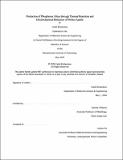Production of phosphorus alloys through thermal reactions and electrochemical reduction of molten apatite
Author(s)
Richardson, Caleb,1792?-1820.
Download1256550764-MIT.pdf (11.58Mb)
Other Contributors
Massachusetts Institute of Technology. Department of Materials Science and Engineering.
Advisor
Antoine Allanore.
Terms of use
Metadata
Show full item recordAbstract
A process for extracting phosphorus from fluorapatite through high temperature electrochemical means. Theoretical modelling and calculations show that P-alloys can be manufactured directly from decomposed molten fluorapatite. Nickel-phosphide is chosen as an examplary alloy both for its incredible thermodynamic stability and for its mechanical properties. Molten hydroxyapatite decomposes as it melts into two solid phosphorus rich phases, tricalcium phosphate and tetracalcium phosphate. Fluourapatite behaves in a similar manner, albeit at a higher temperature. These two calcium phosphates can be reduced to calcium oxide and oxygen in the presence of nickel, forming Ni₃P. Included in this paper is an in-depth overview of current and past phosphorus reduction methods and a discussion of their improvement.
Description
Thesis: S.B., Massachusetts Institute of Technology, Department of Materials Science and Engineering, May, 2020 Cataloged from the official PDF version of thesis. Includes bibliographical references (pages 32-34).
Date issued
2020Department
Massachusetts Institute of Technology. Department of Materials Science and EngineeringPublisher
Massachusetts Institute of Technology
Keywords
Materials Science and Engineering.